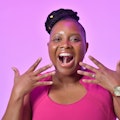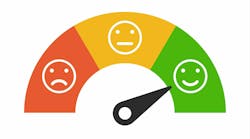Myofunctional therapy: A game changer for DSOs
Historically, in business, a single strategic pivot or revolutionary shift can unleash unprecedented growth. We all remember how Netflix transformed from mailing DVDs to streaming, propelling them to global dominance while Blockbuster met a sluggish demise due to its belated adoption of this groundbreaking innovation. Likewise, retail giant Amazon was once solely dedicated to books before boldly venturing into the vast realm of online mega-retail offerings.
In today’s dynamic business landscape, this ethos of forward--thinking innovation is more crucial than ever, especially in dentistry. This industry grapples with a public perception that all dental offices are uniform and, regrettably, intimidating places. As private practices face a gradual decline, DSOs are poised for substantial growth. However, the real challenge lies in DSOs being able to distinguish themselves from the competition and make a transformative shift that resonates with the public and attracts clinicians.
Enter myofunctional therapy, a century-old modality, that was founded in part by Dr. Edward Angle and his student Dr. Alfred Rogers.1 This exercise-based therapeutic practice holds the potential to spark the Netflix-like growth needed to revolutionize the industry. In this article, we delve into how myofunctional therapy can be the game-changer that propels DSOs to new heights, setting them apart and driving both patient adoption of fee-for-service offerings and clinician enthusiasm.
The DSO industry is currently experiencing an unprecedented surge in growth and market value. Projections indicate that the DSO market is set to expand by 11%-–15% through 2030, with an estimated increase in market value exceeding $400 billion.2 This rapid growth, coupled with the emergence of numerous new DSOs, underscores the critical need for differentiation to capture a more substantial share of this burgeoning market.
Often seen as a subspecialty, myofunctional therapy is a holistic approach to addressing oral dysfunction through cognitive neuromuscular reeducation. It has the potential to not only boost DSO growth but also enhance patient retention and staff satisfaction. Traditionally offered as fee-for-service or via outside referral, myofunctional therapy can now be seamlessly integrated within DSOs as an in-office benefit, enriching patient experience at minimal to no additional cost.
Untapped growth potential
Specialty and multispecialty DSOs have distinctive potential for incorporation. These organizations, encompassing orthodontic, periodontic, pediatric, and sleep providers, are uniquely positioned to be at the forefront of innovation by leveraging an integrative health service model. In this age of information, where currently 89% of the population is more likely to enter their concerns in a search engine than schedule an appointment for evaluation by a medical or dental professional,3,4 it is important to meet evolving demands. A 2022 survey by the National Institutes of Health revealed that one in three Americans actively seek alternative health services when choosing their medical or dental practice.5 More than just an add-on, it serves as a vital adjunctive treatment that amplifies the value of specialized care and has the potential to expedite treatment outcomes significantly.
Undoubtably, patient experience and treatment effectiveness are paramount to success and growth. The addition of myofunctional therapy complements the services provided by multispecialty practices. It addresses critical factors that are often intertwined with orthodontics, periodontics, pediatrics, and sleep medicine, making it an indispensable tool for DSOs. Retention and treatment timelines for orthodontic cases with parafunctional habits, open bites, deep bites, and retruded mandible are expedited and supported in retention when used in conjunction with myofunctional therapy.6 Myofunctional therapy addresses parafunctional habits and enhances essential tongue function. This aids in maintaining the cleansing and salivary microbiome, crucial factors in controlling biomechanical and biochemical factors influencing periodontal health.7,8 It also serves as a valuable adjunctive treatment when managing muscular temporomandibular joint disorder (TMD) and orofacial pain.8 Its inclusion in DSO services can offer patients the desired natural and alternative comprehensive care solutions and improve overall satisfaction without adding to overhead costs.
Surprisingly, despite its immense potential, less than 1% of the industry currently offers myofunctional therapy as an in-office service. This scarcity creates a golden opportunity for forward-thinking DSOs to seize the lead. By doing so, they not only elevate patient care but also give themselves a strong competitive advantage among consumers who struggle to compare dental practices, aside from which ones accept their insurance.
Implementation
The integration of any new service has one simple objective for success: it must not disrupt or negatively impact patient experience. While revenue, patient retention, team acceptance and competence are equally important, changes in patient experience will impact those metrics and determine lasting potential. Establishing a system that integrates seamlessly with the existing workflow is critical to implementation success and can be done in several ways.
The most common strategy is by training dental hygienists to incorporate myofunctional therapy into recall visits. This seamless addition does not disrupt the schedule and may even reduce professional burnout by diversifying the daily routine of the hygienist. This implementation model does not resemble the traditional full experience of a myofunctional therapy program; rather, it offers the patient a low-cost way to gain prestructured programs of exercises that target specific problems such as TMD, mouth breathing, or hyperactive gag. This models the style of a Peloton program where the instructor is providing education and motivation in a library of exercises and checking in during recare appointments.
A more structured and profitable approach is to incorporate full myofunctional therapy programs with dedicated therapists who work across various practices within the organization. Full programs vary in duration but range from six to 12 months. This approach ensures personalization and consistency in patient outcomes. Clinicians assess and refer to the specialist, administrators process insurance preapproval, and the myofunctional therapist works virtually or travels to practices within a designated region to work with patients. Program progress and improvements in orthodontic retention, orofacial pain, and periodontal stability will lead to increased patient satisfaction, retention, and referrals, ultimately contributing to additional practice revenue.
As the DSO industry continues its remarkable growth trajectory, the strategic differentiation offered by myofunctional therapy cannot be understated. It addresses critical aspects of oral health and patient satisfaction, making it a valuable asset for DSOs looking to expand their market share. By embracing myofunctional therapy, DSOs can unlock a world of opportunities, positioning themselves as leaders in comprehensive oral care while improving both patient and staff retention. In an industry where innovation is key, myofunctional therapy emerges as a powerful catalyst for sustained growth and success.
Editor's note: This article appeared in the April 2024 print edition of Dental Economics magazine. Dentists in North America are eligible for a complimentary print subscription. Sign up here.
References
- Boshart CA. Early orthodontists, their challenges, and their significant impact on orofacial myology. Int J Orofacial Myology. 2021;47(1):32-38.
- Dental service organization market size, share report, 2030. Grand View Research. Accessed March 2, 2024. https://www.grandviewresearch.com/industry-analysis/dental-services-organization-market-report#
- Paoloni M, Agostini F, Bernasconi S, et al. Information survey on the use of complementary and alternative medicine. Medicina (Kaunas). 2022;58(1):125. doi:10.3390/medicina58010125
- The most Googled medical symptoms by state. Eligibility Medicare. March 19, 2019. https://eligibility.com/medicare/states-most-googled-medical-symptom
- Van Riel N, Auwerx K, Debbaut P, Van Hees S, Schoenmakers B. The effect of Dr Google on doctor-patient encounters in primary care: a quantitative, observational, cross-sectional study. BJGP Open. 2017;1(2):bjgpopen17X100833. doi:10.3399/bjgpopen17X100833
- Virji SA, Ng ET, Jayachandran S, Heit TC. A case study on myofunctional therapy and malocclusions created by oral habits. Can J Dent Hyg. 2023;57(1):61-68.
- Miremadi SA, Khoshkhounejad AA, Mahdavi E. The prevalence of tongue thrusting in patients with periodontal disease. J Dent Tehran U Med Sci. 2005;2(2):50-53.
- Çetin MB, Sezgin Y, Maras¸ E, Cebeci I˙ Association of probable bruxism with periodontal status: A cross-sectional study in patients seeking periodontal care. J Periodontal Res. 2021;56(2):370-378. doi:10.1111/jre.12829
Karese Laguerre, CRDH, COMP, is a myofunctional therapist, author, and key opinion leader in sleep and myofunctional therapy. She’s the founder of The Myo Spot and the International Association of Airway Hygienists. Through teletherapy, Karese helps clients of all ages overcome tongue ties, TMJ disorders, sleep apnea, grinding, anxiety, and various breathing and orofacial dysfunction. Contact her at [email protected].
About the Author

Karese Laguerre, CRDH, COMP
Karese Laguerre, CRDH, COMP, is a registered dental hygienist, myofunctional therapist, author, and key opinion leader in sleep and myofunctional therapy. She’s the founder of The Myo Spot and the International Association of Airway Hygienists. Through teletherapy, Karese helps clients of all ages overcome tongue ties, TMJ disorders, sleep apnea, grinding, anxiety, and various breathing and orofacial dysfunction. Contact her at [email protected].


